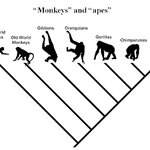Evolution

In my recent article on Understanding natural selection in E:EO, I reviewed a large number of studies that examined conceptions of evolution among students from the high school to undergraduate level, as well as among teachers. However, almost nothing seemed to be known about how graduate students in science perceive evolution or how well they understand it. At least, until a student and I did a study at our own university, which is now out in the journal BioScience.
Here's a press release on it:
Science Students Could Brush Up On Darwin, U of G Study Finds
October 01, 2009 - News Release…

Tomorrow's Science will be a special issue reporting tons of new information on the fossil hominid Ardipithecus ramidus ("Ardi"), which is really exciting (though not as much as Darwinius, which was "like a meteor hitting the Earth" or whatever).
There are news reports of course, including one at USA Today that I want to comment on briefly:
The analysis of Ardipithecus ramidus (it means "root of the ground ape"), reported in the journal Science, changes the notion that humans and chimps, our closest genetic cousins, both trace their lineage to a creature that was more like today's chimp.…

Researchers writing in Science have described Ardipithecus ramidus, a hominid species that lived 4.4 million years ago in what is now Ethiopia.
The last common ancestor shared by humans and chimpanzees is thought to have lived six or more million years ago and Ardipithecus likely shared many of this ancestor's characteristics. In context, Ardipithecus is more than a million years older than the famous "Lucy" female partial skeleton of Australopithecus afarensis. Until the discovery of the new Ardipithecus remains, the fossil record contained scant evidence of other hominids older than…

Sometimes it is helpful to have a catchy word to describe one's type of research. I think that's why "omics" words are so popular -- they encapsulate a complex combination of approaches (usually something + genomics, or something-more-than-genomics) in a memorable way that immediately conveys the gist of the field.
"Metagenomics" is a good example -- it's the study of a larger assemblage of genomes than just one, usually from an environmental sample of microbes. "Proteiomics" is another, or "transcriptomics". Of course, this can get out of hand (see here).
However, I think the study of genome…

This article was pretty interesting. Apparently the gene that is responsible for psychosis is also responsible for creativity too.
I don't know if I can fit this into a larger national security and science picture but I did enjoy the article.

A commenter on a previous post seems to have objected to the claim that evolutionary science makes predictions.
gimme 5 examples of predictions, i mean real predictions: not fit the model hogwash
Marilyn
Here's a list that I put together in around 10 minutes.
1) That a transitional fossil linking fishes and tetrapods would be found in rocks of a specific age (from the Devonian) and formed in freshwater environments. CONFIRMED.
2) That human chromosome 2 would show clear signs of fusion of two chromosomes that are separate in other apes when examined at the level of DNA sequence. CONFIRMED.
3…

Today I gave my lecture on mammal diversity and evolution in the 4th year vertebrate course. We have been talking a fair bit about paraphyletic groups, common vs. scientific names, and so on. Within this context, we explored the issue of whether we're "descended from monkeys", by taking a look at a phylogeny of relevant primates:
The issues that we noted were:
"Apes", as defined as orangutans, gorillas, and chimps, but not humans, is paraphyletic. In other words, either "apes" is not a scientifically defensible term or else it must include humans.
"Monkeys" is paraphyletic, and in particular…

Just came across this nice video by C0nc0rdance summarizing the work of Susumu Ohno and the original concept of junk DNA.
(Oh, and it gets bonus points for using one of my figures!)

An article in LiveScience entitled "Evolution Can't Go Backward" has highlighted an experiment done to determine whether a protein could be "unmutated" (i.e. returned to its original state) and regain its ancestral functions.
The results indicated that this reversibility wasn't possible because of other mutational factors that occurred during the entire time interval rendering a return to a primordial form impossible1.
This does raise an interesting question and suggests some possible misunderstandings about what this actually means.
In the first place, reversibility implies a "memory" of…
Acoelomorpha, a collection of worms which comprises roughly 350 species, is part of a much larger group called bilateral animals, which are organisms that have symmetrical body forms and include humans, insects and worms. Apparently there has been a question about acoelomorpha, namely where do they fit in taxonomically?
Acoelomorpha has been a "rogue animal," says Casey Dunn, an evolutionary biologist at Brown University. "It has been wandering throughout the animal tree of life."
(?!?)
The worm wanders no more, he now says. Through genetic sequencing analysis, Dunn and collaborators claim to…